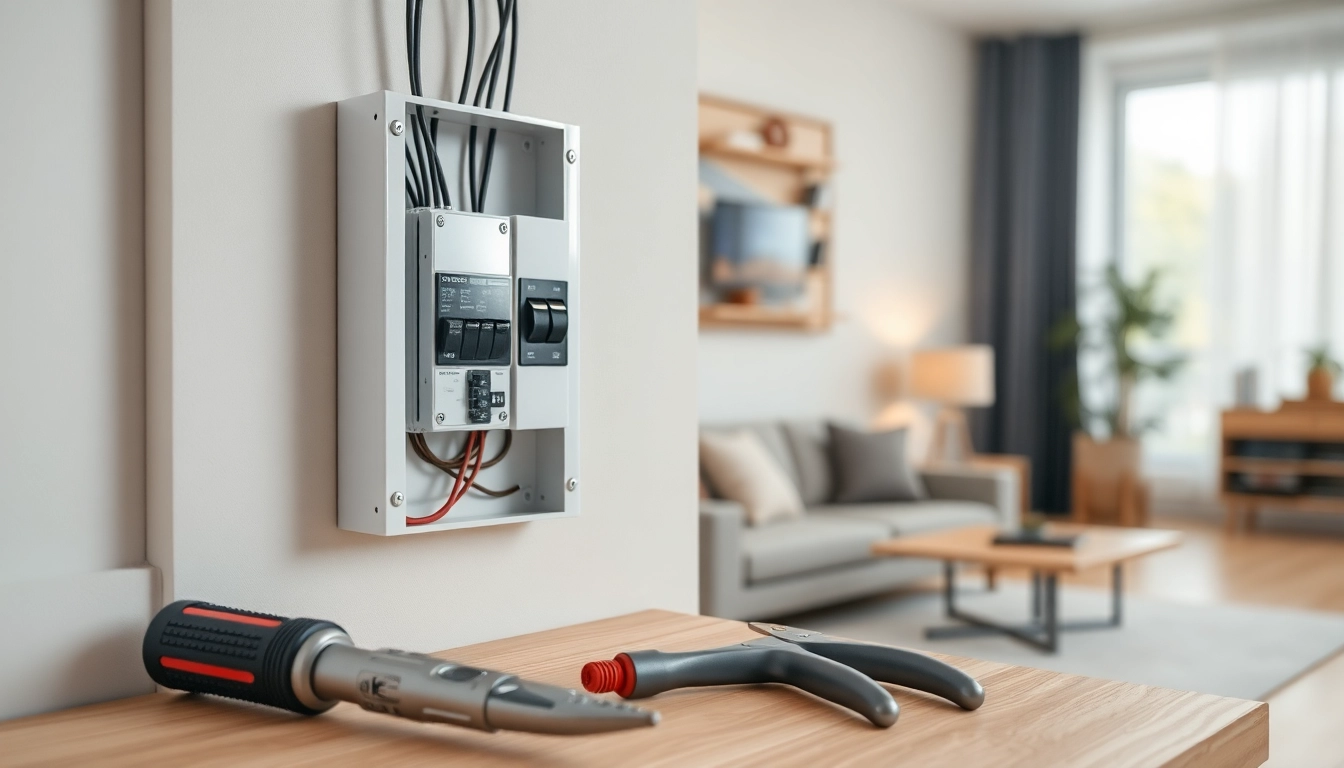
Understanding Electrical Panels: Basics and Components
What is an Electrical Panel?
An Electrical Panel, also known as a breaker panel or service panel, serves as the central hub of your home’s electrical system. It is responsible for receiving electrical power from the utility company and distributing it throughout your home to various circuits and systems. Every circuit in your home that powers lights, appliances, and outlets connects to this critical unit.
These panels can vary greatly in size and functionality, ranging from smaller boxes that serve a compact space to larger units capable of handling the electrical demands of larger homes or commercial settings. In essence, the electrical panel is not merely a conduit for electricity; it encapsulates vital safety and regulatory elements designed to prevent overloads, fires, and other electrical hazards.
Key Components of Electrical Panels
Understanding the basic components of an electrical panel can help homeowners make informed decisions about upgrades, maintenance, or replacements. Here are the main elements of a typical electrical panel:
- Main Breaker: The principal switch that controls power flow to the entire panel. It is a crucial safety feature that can shut off all electricity in case of an emergency.
- Branch Breakers: These are individual switches that control power to specific circuits throughout the home. If a circuit overloads, the corresponding branch breaker will trip to prevent damage.
- Main Lug Panels: Found in situations where a separate disconnect switch is used, these panels direct power without a main breaker in the unit.
- Bus Bars: Metal bars that distribute electricity from the main breaker to the branch breakers.
- Grounding Bars: Essential for safety, these bars connect the grounding wires from circuits to the grounding system of the home.
- Labeling: A vital component for safety and functionality, proper labeling of the circuits helps in troubleshooting and disconnecting power when necessary.
Significance of an Up-to-Date Panel
Keeping your electrical panel up to date is not only a matter of efficiency; it is critical for safety. As electrical codes change, older panels may not comply with current standards, leading to potential hazards. Additionally, advancements in technology demand more power than older systems were designed to handle. For instance, the increasing reliance on smart home devices, high-efficiency appliances, and renewable energy sources such as solar panels requires a reliable electrical infrastructure.
Upgrading your electrical panel can enhance your home’s energy efficiency, increase capacity to meet future electrical needs, and improve overall safety by minimizing the risk of electrical fires and failures.
Signs It’s Time to Upgrade Your Electrical Panel
Common Symptoms of an Overloaded Panel
Recognizing the signs of an overloaded electrical panel is essential for preventing dangerous situations. Frequent issues include:
- Tripped Breakers: If your breakers trip often, it could indicate that the panel is overloaded. This may occur when too many devices are drawing power simultaneously.
- Flickering Lights: Dimming or flickering lights, especially when using large appliances, suggests insufficient power supply.
- Buzzing Sounds: Any unusual sounds coming from the panel itself can indicate internal issues that may require immediate attention.
- Warmth or Discoloration: If the panel feels warm or shows signs of discoloration, it may be overheating, posing a serious fire risk.
Code Compliance and Safety Standards
As codes evolve, it is vital to ensure that your electrical panel complies with the latest safety standards. Various jurisdictions may enforce different codes regarding panel installation, grounding requirements, and circuit capacities. Upgrading your panel ensures adherence to these regulations, potentially saving you from fines or hazards associated with non-compliance. Additionally, modern panels provide enhanced protective features, such as ground fault circuit interrupters (GFCIs) and arc fault circuit interrupters (AFCIs) that help to eliminate risks of overloads, shocks, and electrical fires.
Energy Efficiency Improvements
Today’s electrical panels can significantly contribute to energy efficiency. Older panels might not support energy-efficient appliances or smart technologies, leading to higher energy costs. Upgrading to a newer model can allow for better energy management, such as implementing load balancing and smart energy monitoring systems that allow homeowners to track and optimize their energy use. This transition can lead to lower utility bills and a reduced carbon footprint.
Choosing the Right Electrical Panel for Your Needs
Types of Electrical Panels Available
When it comes to selecting an electrical panel, it’s crucial to understand the various types available in the market:
- Standard Residential Panels: Typically rated between 100-200 amps, these panels are common in homes and can handle standard power loads.
- High-Efficiency Panels: Designed for homes with higher power demands, usually exceeding 200 amps, these panels include features for managing smart appliances and renewable energy systems.
- Sub-Panels: These supplementary panels are used to distribute power to specific areas in larger homes or garages without overloading the main panel.
- Smart Panels: These cutting-edge panels incorporate technologies that allow homeowners to control their electrical system via mobile apps, providing insights into usage patterns and potential savings.
Factors to Consider When Selecting a Panel
Selecting the right electrical panel involves careful consideration of several factors, including:
- Home Size and Electrical Load Requirements: Assessing your current and future electrical usage will determine the necessary panel capacity.
- Number of Circuits Needed: Depending on the appliances and devices you use regularly, you may need a panel with more branch circuits.
- Future Expansion: Consider potential upgrades for your home that may require additional power, such as adding electric car chargers or high-capacity air conditioning systems.
- Budget: Ensure that your selected panel fits within your budget while meeting all necessary power requirements and safety standards.
Comparing Popular Electrical Panel Brands
There are several reputable brands in the electrical panel market, each with its features, advantages, and price points. Here are a few worth considering:
- Square D: Known for their reliability and innovative features, Square D panels are widely used in residential and commercial buildings. Their QO panels offer superior overload protection.
- Siemens: Offering a variety of models, Siemens panels are known for their flexibility and performance, including compact designs suitable for tighter spaces.
- GE: General Electric’s panels are praised for their affordability and effectiveness, catering to budget-conscious consumers while maintaining quality.
When comparing brands, consider factors such as warranty, availability of parts, and compatibility with your existing systems.
Installation Process: What to Expect
Hiring a Professional Electrician
While some homeowners may consider DIY installation, it’s highly recommended to hire a licensed electrician for any electrical panel work. This is essential not only for compliance with local codes and regulations but also for ensuring safety. A qualified electrician will assess your home’s requirements and help select an appropriate panel. They will also correctly handle wiring and connections to prevent any hazards.
Pre-Installation Checklist
Before the installation, it’s essential to prepare adequately:
- Assess Your Electrical Needs: Re-evaluate the load your home requires and decide if an upgrade is necessary.
- Check Local Codes: Ensure that you understand local regulations and inspection requirements before proceeding.
- Prepare the Install Site: Ensure the installation area is accessible and clear of obstructions for ease of the electrician’s work.
Post-Installation Safety Checks
Once the installation is complete, several checks should be conducted:
- Test All Circuits: Ensure that all circuits in the electrical panel are functioning correctly and that breakers trip appropriately under load.
- Verify Grounding: Check that all grounding connections are secure and compliant with safety standards.
- Document Changes: Update your home’s electrical system documentation to reflect the new installation for future reference and maintenance.
Maintaining Your Electrical Panel Over Time
Regular Inspection Tips
Regular inspections of your electrical panel can help prevent potential problems:
- Conduct visual checks for signs of wear or damage.
- Look for tripped breakers or frequent issues that could indicate deeper electrical problems.
- Schedule professional inspections at least once every five years, or sooner if you notice issues.
Signs of Wear and Tear to Monitor
Be aware of signs that indicate your electrical panel may require attention:
- Rust or Moisture: Any signs of rust or moisture should prompt immediate evaluation.
- Burn Marks: Any discoloration or burn marks on the panel can signal dangerous overloads.
- Noisy Equipment: Buzzing or popping noises can indicate serious internal problems.
Upgrading vs. Replacing: Making the Right Choice
Deciding whether to upgrade or completely replace your electrical panel involves evaluating your current system’s performance:
- Upgrade: If your panel is functioning adequately but just doesn’t meet current needs, upgrading the existing panel can be a cost-effective solution.
- Replace: If your panel is outdated or damaged beyond reasonable repair or if the upgrade options are limited, a full replacement is advisable.
Overall, maintaining a safe and efficient electrical system is crucial for any homeowner. Regularly assessing and upgrading your electrical panel not only enhances safety but also maximizes energy efficiency, ensuring your home remains equipped for modern demands.







